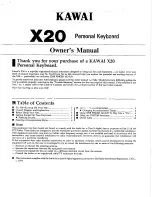
118
Creating a Rhythm Set
Rhythm Tone Name
You can assign a name of up to 12 characters to the rhythm tone.
By pressing [ENTER], you can assign a name to the rhythm tone.
Value:
space, A-Z, a-z, 0-9, ! ” # $ % & ’ ( ) * + , - . / : ; < = > ?
@ [ \ ] ^ _ ` { | }
For details on assigning names, refer to
Assign Type
Assign Type sets the way sounds are played when the same key is
pressed a number of times.
Value
MULTI:
Layer the sound of the same keys. Even with
continuous sounds where the sound plays for an
extended time, such as with crash cymbals, the
sounds are layered, without previously played
sounds being eliminated.
SINGLE:
Only one sound can be played at a time when the
same key is pressed. With continuous sounds where
the sound plays for an extended time, the previous
sound is stopped when the following sound is
played.
Mute Group
On an actual acoustic drum set, an open hi-hat and a closed hi-hat
sound can never occur simultaneously. To reproduce the reality of
this situation, you can set up a Mute Group.
The Mute Group function allows you to designate two or more
rhythm tones that are not allowed to sound simultaneously. Up to 31
Mute Groups can be used. rhythm tones that are not belong to any
such group should be set to “OFF.”
Value:
OFF, 1–31
Tone Env Mode (Rhythm Tone Envelope Mode)
When a loop waveform (p. 116) is selected, the sound will normally
continue as long as the key is pressed. If you want the sound to decay
naturally even if the key remains pressed, set this to “NO-SUS.”
Value:
NO-SUS, SUSTAIN
If a one-shot type Wave (p. 116) is selected, it will not sustain
even if this parameter is set to “SUSTAIN.”
Tone Pitch Bend Range
(Rhythm Tone Pitch Bend Range)
Specifies the amount of pitch change in semitones (4 octaves) that
will occur when the Pitch Bend Lever is moved. The amount of
change when the lever is tilted is set to the same value for both left
and right sides.
Value:
0–48
Tone Receive Expression
(Rhythm Tone Receive Expression Switch)
For each rhythm tone, specify whether MIDI Expression messages
will be received (ON), or not (OFF).
Value:
OFF, ON
Tone Receive Hold-1
(Rhythm Tone Receive Hold-1 Switch)
For each rhythm tone, specify whether MIDI Hold-1 messages will
be received (ON), or not (OFF).
Value:
OFF, ON
If “NO-SUS” is selected for Env Mode parameter (p. 118), this
setting will have no effect.
Tone Receive Pan Mode
(Rhythm Tone Receive Pan Mode)
For each rhythm tone, specify how pan messages will be received.
Value
CONTINUOUS:
Whenever Pan messages are received, the stereo
position of the tone will be changed.
KEY-ON:
The pan of the tone will be changed only when the
next note is played. If a pan message is received
while a note is sounding, the panning will not
change until the next key is pressed.
If
(p. 157) is on, the Tone Receive
Pan Mode setting is ignored.
The channels cannot be set so as not to receive Pan messages.
One Shot Mode
The sound will play back until the end of the waveform (or the end
of the envelope, whichever comes first). The result will be the same
as when the envelope’s Tone Env Mode parameter (p. 118) is set to
NO-SUS. If you have set Wave Group (p. 119) to Sample, the loop
setting will be forced to ONE SHOT.
Value:
OFF, ON
Fantom-G_r_e.book 118 ページ 2009年7月2日 木曜日 午後2時55分
















































